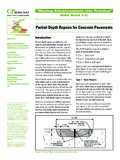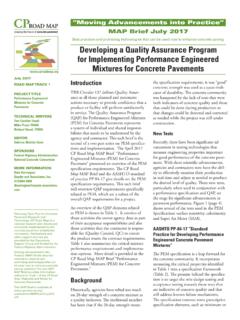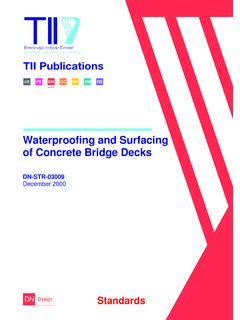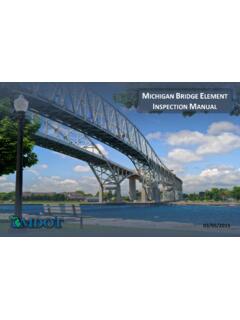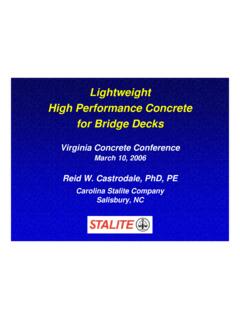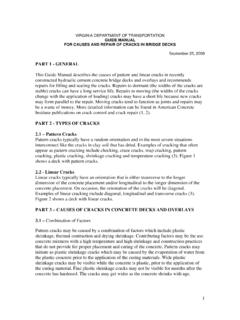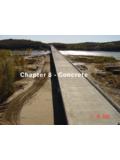Transcription of Causes of Early Cracking in Concrete Bridge Decks
1 Moving Advancements into Practice . MAP Brief November 2016. Best practices and promising technologies that can be used now to enhance Concrete paving Causes of Early Cracking in Concrete Bridge Decks November 2016. Introduction It is generally accepted that the occurrence of Early -age deck Cracking is mainly due to the ROAD MAP TRACK 6 The problem of deck Cracking has existed in restraint of Concrete volume change by the bridges for many years. The cracks com- girders and supports. It is also thought that PROJECT TITLE monly occur after construction but before Causes of Early Cracking in the major cause of Concrete volume change the Bridge is opened to traffic ( , days is a combination of shrinkage and thermal Concrete Bridge Decks following Concrete placement). Figure 1 is effects (including temperature drop after heat an example of such a Bridge .)
2 In this particu- of hydration, autogenous shrinkage, dry- TECHNICAL WRITERS. Yaohua Deng lar case, the evidence of Cracking on both ing shrinkage, and plastic shrinkage due to Bridge Engineering Center the top and bottom of the deck (commonly evaporation of the mix water). The amount Iowa State University observed only on the bottom initially) of Concrete volume change and the degree of Brent Phares indicates that this Bridge is particularly restraint are dependent upon many factors Bridge Engineering Center susceptible to moisture and chloride in- that can be generally categorized into three Iowa State University gress the cracks provide a direct pathway broad categories: Dale Harrington for the intrusion of water and chlorides. In Snyder and Associates, Inc. the worst case, these Early -age cracks could Concrete material properties and lead to a reduced Bridge - deck service life.
3 Proportions EDITOR. Interestingly, there have been instances Structural design attributes of the Bridge Sabrina Shields-Cook where Cracking has occurred in only one of associated with the structural interaction SPONSORS twin, side-by-side bridges. This situation is between the deck and other components Federal Highway Administration confusing the two structures should be National Concrete Consortium the same, yet only one experiences Cracking . Construction environment and techniques MORE INFORMATION. Dale Harrington Snyder and Associates, Inc. (515)964-2020. com The Long-Term Plan for Concrete Pavement Research and Technology (CP Road Map) is a national research plan developed and jointly implemented by the Concrete pavement stakeholder community. Publications and other support services are provided by the Operations Support Group and funded by the Federal Highway Administration.
4 Moving Advancements into Practice (MAP) Briefs describe innovative research and promising technologies that can be used now to enhance Concrete paving practices. The March 2016. MAP Brief provides information relevant to Track 6 of the CP. Road Map: Concrete Pavement Construction, Reconstruction, and Overlays. This MAP Brief is available at Figure 1. Cracking (marked on deck surface) occurred before this newly constructed Bridge was opened to traffic. org/publications/. CP Road MAP Brief November 2016. Because the number of factors is large and the Cracking Material, Structural, and Construction mechanisms related to different factors are complex and highly interactive, it is not easy to conclusively identify the relation- Conditions ships between the factors and the development of deck cracks. A review of available information reveals the potentially In fact, analysis of the Causes of deck Cracking , taking into ac- important material, structural, and construction con- count only one or some of these factors, has led to somewhat ditions/factors that may either increase or reduce the biased opinions.
5 Any attempt to understand the interaction amount of Cracking in Bridge Decks . The factors are sum- between factors must include a systematic statistical analysis marized in Tables 1 through 3 with brief descriptions as to of the actual correlations between the degree of deck Cracking how they can positively or negatively affect the degree of and the magnitudes/characteristics of all the important factors. deck Cracking . Only in this way can the interactive effects due to different factors be identified. Table 1. Relationships of material properties/proportions and Concrete deck Cracking Concrete deck Material/Mixture Effects on Concrete deck Cracking Factors Cement type, content, and proportion Thermal shrinkage (hydration) and dry shrinkage (water loss) are influenced by the type of cement. Type II cements help reduce thermal stresses and thus Cracking .
6 Type-K shrinkage-compensating cement is associated with less shrinkage Cracking . Type-K. cement develops expansive characteristics in the Concrete that, when properly restrained from expansion, develop compressive stresses. The tensile stresses due to dry shrinkage and other factors have to overcome the compressive stress and tensile strength of the Concrete before cracks can form. Supplementary cementitious materials such as fly ash, slag, and natural pozzolans reduce the rate of hydration of the cement paste, decreasing the set time, temperature rise, and Early strength development and thus the potential for thermal Cracking . Aggregate contents/type Aggregate content (type, size, volume, and gradation) has an effect on shrinkage and absorption of the Concrete . Low shrinkage aggregates with high aggregate-to-paste ratio and low coefficient of thermal expansion can reduce Cracking .
7 Internal curing the process of replacing approximately 30% of the volume of fine aggregate with water-filled lightweight aggregate is a relatively new practice that improves Concrete 's overall performance. The pre-wetted aggregate increases the amount of water available for cement hydration without affecting the water-to-cement ratio and disperses the curing water throughout the depth of the Concrete , thus increasing the reaction of the cementitious materials over time. Internal curing will measurably reduce autogenous shrinkage Cracking , reduce plastic shrinkage Cracking , and by increasing the extent of the hydration reaction reduce fluid transport. Internal curing has primarily been used in Bridge Decks in Illinois, Indiana (8), Iowa, New York (9), and Utah (10). For detailed information about internal curing, see the December 2015 MAP Brief (Weiss 2015).
8 Air content Increasing the air content (especially >6%) decreases dry shrinkage of Concrete and thus lowers the potential for Cracking . Other admixtures Water reducers reduce the amount of water needed for a workable mix and can thus reduce drying shrinkage. Shrinkage-reducing admixtures reduce dry shrinkage (but can have the side effect of reducing the efficiency of some air-entraining admixtures and may cause some scaling after several freeze-thaw cycles). Retarding admixtures delay hydration and thus the potential for dry shrinkage cracks (but may be a disadvantage in cold-weather projects). Concrete slump/water content Higher Concrete slump is associated with increased Cracking because it is related to increased Concrete settlement over steel rebar. Low water-to-cement ratio is associated with reduced Cracking because it helps reduce volume change and Concrete shrinkage.
9 2. CP Road MAP Brief November 2016. Table 2. Relationships of structural design attributes with Concrete deck Cracking Structural Factors Effects on Concrete deck Cracking Concrete strength High strength Concrete has an increased stiffness, which promotes crack development. Concrete strengths should not be allowed to be excessively high. Modulus of elasticity (Ec) increases faster than strength for the first 3 to 5 hrs after initial set, potentially leading to Cracking . The modulus can be lowered using lower Ec aggregate with reasonable compressed strength. Span type Interior spans are associated with increased restraint, and thus increased Cracking , compared to end spans, due to the restraint provided by the intermediate supports. Girder type Curved girders and slab Bridge Decks are related to increased Cracking compared to slabs on stringer girders.
10 Simply supported girders impose less restraint on the deck than multi-span continuous composite large steel girders. End restraint condition Fixed-ended conditions ( , integral abutments) and unintended boundary restraints are associated with increased Cracking . Simply-supported conditions are associated with reduced Cracking . Top transverse bars Large size bars are associated with increased Cracking due to the bars' higher relative stiffness. Girder depth/spacing High relative girder-to- deck stiffness is associated with increased Cracking Wide flanges and composite steel plate girders may be associated with restraint-induced Cracking . Cross-frame location Stress concentrations between cross-frames and steel girders are associated with increased deck Cracking . Expansion joints Expansion joints accomodate Concrete movement, reducing the potential for Cracking .
